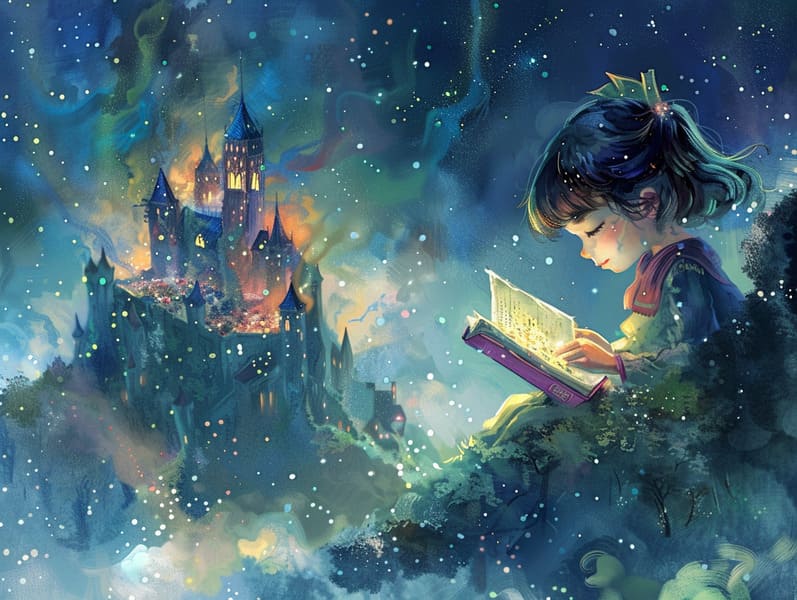
Historical fairy tales have legendary status. These tales have been conveyed from one generation to the next far before they were ever written down. They sprang from a variety of cultures, including African traditions. They were initially passed along among grown-ups, often carrying themes and messages concerning the societal norms and beliefs of the time.
The famous Grimm duo, Jacob and Wilhelm, were among the first to compile and release many of these beloved tales. Their anthology, "Grimm's Story Collection," included narratives like "Ashenputtel," "Little Brother and Little Sister," and "The True Story of Snow White," which have since become staples in the world of famous fairy tales. Similarly, Hans Andersen's enchanting fairy tales, such as "The Mermaid," and "The Ugly Duckling," have won hearts worldwide, securing their place in the pantheon of beloved fairy tales.
Though they are old, these tales remain as important as ever, especially as bedtime stories for kids. These delightful tales are now available in various formats, including artistically illustrated books, delightful animations, and internet fairy tales.
Their lasting appeal can be traced to several delightful features:
Ethical Lessons: Traditional fairy tales often teach important moral lessons. Fairy tales like "The Boy Who Cried Wolf" teach the virtue of sincerity, while "The Story of the Tortoise and the Hare" show the merits of perseverance and unassuming nature. These stories offer children clear distinctions between moral and immoral, guiding their moral compass in a subtle yet important way.
Compassion and Knowledge: Fairy tales frequently illustrate beings facing struggles and tests, fostering children to understand with their struggles and support their triumphs. For instance, "Beauty and the Beast" emphasizes the benefit of looking past the exterior to perceive the inner core of a being, encouraging insight and awareness.
Cultural Recognition: Many fairy tales are infused with the cultural contexts from which they originated. Understanding these tales can provide informative snapshots into different cultures, developing a sense of cultural awareness and recognition.
Creativity and Fantasy: The mythical elements in fairy tales—magical kingdoms—enhance children’s imaginative ideas. These tales move readers to magical realms, inspiring fantasy ideas and a sense of marvel that persists a lifetime.
Classic fairy tales are not only alluring but also enlightening. They act as fantastical tools in strengthening various cognitive and emotional skills in the young. When ancient fairy tales are recited, they strengthen language proficiency by presenting new language and complicated sentence structures. This practice also nurtures auditory skills and attentiveness, as the young concentrate deeply, keen to see what happens next.
Furthermore, discussing the themes and characters of classic fairy tales can cultivate thought processes and thinking skills. Young ones learn to identify patterns, make predictions, and get cause and effect. These deliberations also advance the young say their thoughts and feelings, promoting their emotional intelligence.
In today’s digital era, the proliferation of digital fairy tales has made these narratives more attainable than ever. Websites and apps supply large libraries of ancient fairy tales that can be browsed or played anytime, anywhere. Fairy tales told out loud are particularly widespread, supplying an engaging way for the young to experience these delightful tales. Read-aloud books and narrated videos lead characters and settings to life, often supported by bewitching harmonies and musical scores that improve the storytelling journey.
The timeless fascination of classic fairy tales lies in their ability to adapt to modern times while staying true to their key morals. Contemporary takes of these stories often bring in more diverse characters and modern settings, making them pertinent to today’s audience. However, the main ideas of fortitude, empathy, and equity remain unchanged, continuing to impact readers of all ages.
Classic fairy tales also offer a sense of security and predictability. They feature a well-arranged narrative with a apparent beginning, middle, and end, often wrapping up this site with the conclusion of conflicts and the triumph of truth over falsehood. This foreseeability can be comforting for children, extending a sense of solidity in an constantly changing world.
Ancient fairy tales continue to allure and edify new generations, maintaining their mystique and importance in modern society. As nighttime stories for kids, they make available a perfect blend of charm and understanding, nurturing moral values, empathy, and creativity. The availability of web-based fairy tales and the popularity of fairy tales told out loud affirm that these old narratives remain available to new generations.
By retaining and disseminating these fairy tales, we continue to cherish the rich tapestry of folklore and cultural heritage. Whether you are delving into a gorgeously illustrated book, experiencing a cyber collection, or listening through an narrated book, the magic of Grimm's fairy tales is always within reach. These narratives illustrate of the endless spell of narratives and its ability to unite us across generations and cultures.
Whether you are viewing a gorgeously illustrated book, viewing a digital collection, or hearing an read-aloud story, the enchantment of traditional fairy tales is always within reach.
These fairy tales demonstrate of the endless magic of storytelling and its ability to connect us across centuries and lands, weaving a spell that enchants and educates alike.
Comments on “The Story Behind Short Fairy Tales with the Unwavering Grace.”